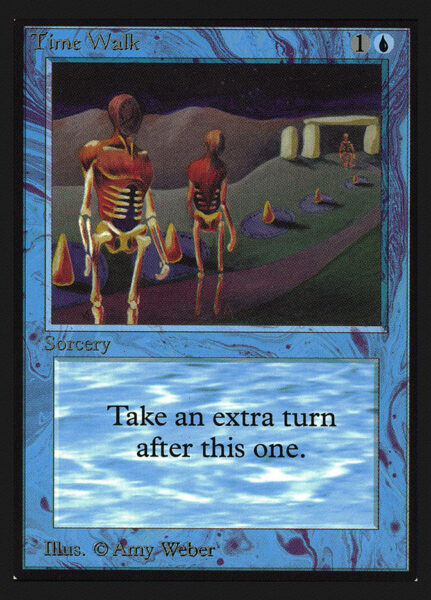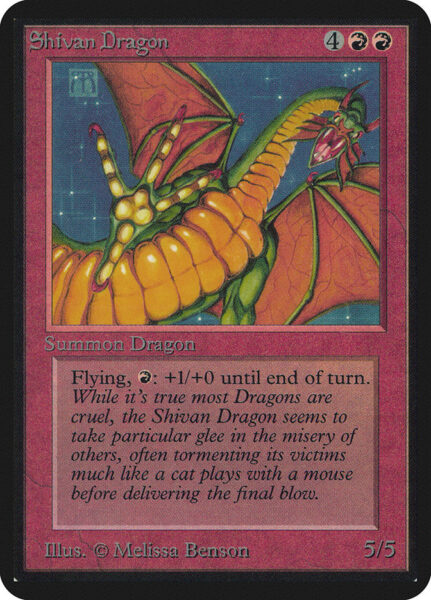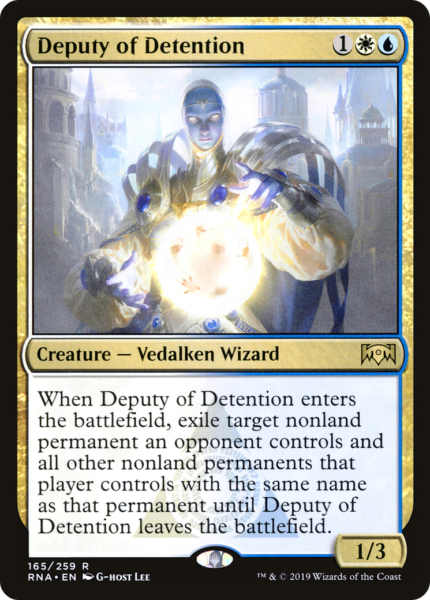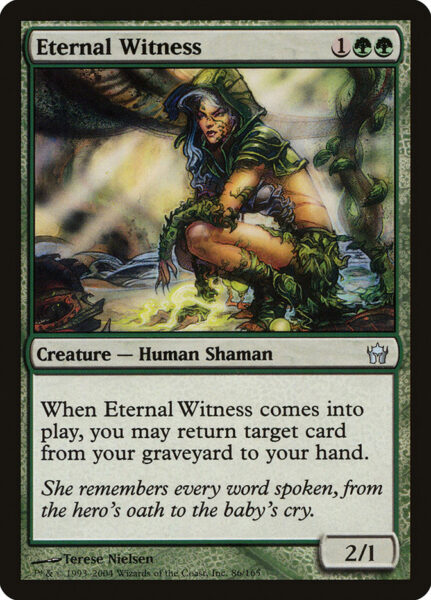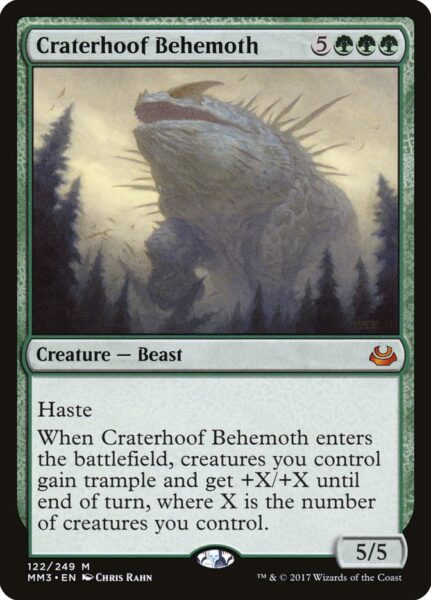by Johnny Cycles, April 11th, 2024

Want to grind out your opponents with an endless stream of 2-for-1s? Love enter-the-battlefield effects? Dreading the release of Bloomburrow when cards will begin to read “enters” instead? Wait, no… Love midrange, control-style strategies that can go wide and go big? Then this is the deck for you!
Decklist – Bant Blink with Roon of the Hidden Realm
| Roon of the Hidden Realm |
Creatures (27)
| Meddling Mage | |
| Scavenging Ooze | |
| Scheming Fence | |
| Snapcaster Mage | |
| Deputy of Detention | |
| Endurance | |
| Eternal Witness | |
| Fierce Empath | |
| Reflector Mage | |
| Skyclave Apparition | |
| Spellseeker |
| Spell Queller | |
| Uro, Titan of Nature’s Wrath | |
| Venser, Shaper Savant | |
| Yasharn, Implacable Earth | |
| Acidic Slime | |
| Chulane, Teller of Tales | |
| Elesh Norn, Mother of Machines | |
| Seedborn Muse | |
| Solitude |
| Greenwarden of Murasa | |
| Sun Titan | |
| Torrential Gearhulk | |
| Agent of Treachery | |
| Craterhoof Behemoth | |
| Hornet Queen | |
| Moonshaker Cavalry |
Planeswalkers (9)
Artifacts (7)
| Mana Crypt | |
| Mana Vault | |
| Arcane Signet | |
| Chromatic Lantern | |
| Coalition Relic | |
| Panharmonicon | |
| The Great Henge |
Enchantments (2)
| Sylvan Library | |
| Wilderness Reclamation |
Instants (11)
| Brainstorm | |
| Swords to Plowshares | |
| Counterspell | |
| Cyclonic Rift | |
| Growth Spiral | |
| Mana Drain | |
| Fierce Guardianship | |
| Flawless Maneuver | |
| Render Silent | |
| Cryptic Command | |
| Force of Will |
Sorceries (4)
| Ponder | |
| Preordain | |
| Supreme Verdict | |
| Wrath of God |
Lands (39)
Boseiju, Who Endures
Breeding Pool
Cavern of Souls
Eiganjo, Seat of the Empire
Fabled Passage
Flooded Strand
Flooded Grove
Glacial Fortress
Hallowed Fountain
Hedge Maze
Hinterland Harbor
Horizon Canopy
Lush Portico
Meticulous Archive
Misty Rainforest
Otawara, Soaring City
Prairie Stream
Reliquary Tower
Spara’s Headquarters
Strip Mine
Sunpetal Grove
Temple Garden
Wasteland
Waterlogged Grove
Windswept Heath
Forest (5)
Island (5)
Plains (4)
My Play Deck
Back in the 90s when I first started playing Magic, long before Standard, Modern, or Commander, we used to call our best and/or favorite deck our Play Deck. Anything else, and since I was in high school at the time there was really hardly ever anything else, was just called by what it was. Land destruction. Goblins. Control. Whatever. But your Play Deck…that was your baby.
Well, this is my Play Deck for Commander. This is the deck I’ve had longer than any other. It is the deck I love playing. It is the deck I put my expensive mana rocks in. It is also the deck where I play my most favorite cards, regardless of power level. It is the deck I spent waaay toooo much money on foiling out during Covid lockdown.
It is also the deck that most suits my play style – Creature Control.
When I first got back into Magic in 2011, I immediately gravitated towards all the powerful and busted creatures the game has to offer. For those of you who played in the beginning or simply know the history of Magic, creatures were woefully underpowered back then compared to other spell types.
One of these things is not like the other…
This changed in the ten years I took off between roughly Ice Age and Innistrad. So when I started playing again, I was amazed at the power level of the creatures, particularly the slightly undercosted bombs (compared to the OG bombs, Shivan Dragon or Force of Nature). They had no drawback! It was all upside! I had to play these amazing creatures!
An unbeatable 2-card combo…or so I thought back in 2011.
My first Standard decks back then played a comically dated strategy straight from the 90s. I was floored by the concept of hexproof and tried really hard to make Elgaud Shieldmate and Primordial Hydra work. I lived that dream once before realizing its fragility and weakness against the field. This was the Standard of Delver of Secrets, Birthing Pod, and Gitaxian Probe. And, to make matters worse, that one time I pulled it off, my opponent scooped before I got to attack with my massive, hexproof, trampling Hydra! You can see, though, that my janky nature has been with me since the beginning.
However, it wasn’t long before I moved away from big creatures and towards a more interactive strategy. The next two decks I really enjoyed were Aristocrats and Mardu Midrange. Aristocrats was my first taste of the power of synergistic creature cards that were greater than the sum of their parts, while my Mardu deck led me down the route of cheap, efficient creatures backed up with removal. What I learned from these early decks is that I really like creatures that do things other than attack and I hate running out of gas.
Enter .
I never thought I’d be a dreaded, hated Blue player. Control was anathema to me. Back in the 90s, I had a friend who loved playing Control. He had a U/W deck that answered what I was doing – playing Dragons, unsurprisingly – easily until he eventually locked me out of the game. I don’t remember the combo at this point. I only remember that he kept playing Magic, while I didn’t. It was brutal.
But with age and experience comes a more open mind…at least, it should. Blue had a lot of appeal to me precisely in the card draw it offers. Of course, in today’s world of a broken, warped color pie, card draw is ubiquitous in every single color. But Blue still does it best. And, as I experimented with the formerly forbidden, I realized I actually enjoyed the Control strategy. Holding up mana to counter an opponent’s spell was not the first step on the pathway to hell. It was actually quite fun.
But my first love is still creatures. How could I play a Control deck that still plays a lot of creatures?
Enter-the-battlefield (ETB) effects plus Roon of the Hidden Realm is how.

Back in the 90s, ETBs on creatures didn’t exist. It’s true that there are a handful of exceptions (Hazezon Tamar from Legends in 1994), but the vast majority of creatures didn’t do things when they resolved. Some of them could do things after resolution, but it took awhile for Wizards to figure out that they could essentially attach a sorcery or an instant to a creature. Eternal Witness is just a Regrowth attached to a Savannah Lions after all.
By the early 2010s, more and more creatures were doing things upon entering the battlefield. And over the course of the following decade, ETB effects have become one of the main ways to distinguish playable creatures from unplayable. In fact, the prevalence of ETB effects attached to creatures has allowed for entire new archetypes to arise (Death and Taxes), while also breathing new life into old ones (Control).
For me and my newly discovered love of Control strategies, ETBs on creatures has given me the chance to build the kind of deck that suits my play style – Creature Control. I get to play creatures up the curve and my primary win condition is through either go-wide or go-big combat (or both). But the creatures I’m playing all have ETBs that interact with what my opponent is doing in a way that functions like a Control deck. Roon of the Hidden Realm, printed for the first time in a Commander Precon in 2013, is the rug that ties the room together. His ability to exile and return our creatures gives us an inevitability that will be hard for fair decks to overcome.
Now let’s get to the deck!
Primary Game Plan
What’s better than one ETB effect on a creature? Two? Three? Four? As many as it takes to win!
We are primarily looking to manage the game via a variety of ETB effects until we can untap with our commander on the battlefield. We then either grind out victory by blinking (exiling, then returning a permanent to the battlefield) whatever creature has the ETB we need at the moment, or we stick one of our finishers (which also happen to have ETBs of their own). Repeat as often as possible.
Before we continue, it’s worth highlighting that the creatures we exile with Roon return only at the next end step. This is technically not blinking, but for simplicity’s sake, I’ll refer to this as blinking throughout. However, this is a very important distinction to remember during the game.
Ours is a midrange, grindy strategy looking to gain incremental value that will eventually snowball into a victorious avalanche! Along the way, we get to play some of Magic’s best interactive noncreature spells (Counterspell, Swords to Plowshares) alongside some of the best Planeswalkers ever printed (Oko, Thief of Crowns, Jace, the Mind Sculptor, Teferi, Hero of Dominaria). It is a recipe for a highly interactive deck that can turn the corner on a dime and win in a single attack.
Our gameplan also has strong elements of Prison decks, as well as of Flash decks. With this in mind, playing this deck can feel a lot like solving a puzzle. We need to find the right parts to answer what our opponent is doing. But where my Mono-White Prison deck relies more on finesse and niche answers, Roon of the Hidden Realm wants to run over our opponent’s strategy with our value train of repeated ETBs. Sure, we have some narrowish answers (Endurance), but our deck is largely made up of broad responses to most things (Meddling Mage, Venser, Shaper Savant, Agent of Treachery), whose ETB we can get maximum value out of with our commander.
ETB Creatures
Of the 27 creatures we play, 23 have ETBs for us to abuse. These can be divided into several categories. First, we have creatures whose ETB interferes with our opponent’s game plan. Second, we play creatures whose ETB gains us card advantage in some form or another. And third, we have our finishers, whose ETBs allow us to go wide or go big and win in a single attack. The remaining four creatures, not including our commander, support our strategy in their own way.
ETBs that Hinder our Opponent
Meddling Mage – as a 2-drop, this Human Wizard can come down before the large majority of commanders and stop our opponent from playing their centerpiece card until they answer it. Forcing our opponent to use a kill spell on a lowly 2/2 is already a win. In the late game, we can use our commander to blink Meddling Mage to stop whatever other cards we may be worried about. We can even blink it on one opponent’s turn, untap, then blink it before another opponent’s turn. Will this make us the enemy at the table? Probably. Is it fun? Most definitely!
Scheming Fence – another 2-drop that can derail our opponent’s plans early and late. It’s a Pithing Needle on a 2/3 creature that gains the nerfed ability. Wow! I’ve yet to play this Human Citizen and always think long and hard about cutting him whenever a new set comes out, but there is just soooo much value here. Of course, this is all value without our commander out. With Roon, we get to reset whatever Scheming Fence targets if our opponent plays something more powerful or more dangerous.
Snapcaster Mage – the OG Modern staple that’s made a recent comeback thanks to cards like Flame of Anor, this 2/1 with Flash plus our commander makes our graveyard a more-than-one-time extension of our hand.
Deputy of Detention – a Detention Sphere on a body that we can blink? This is the kind of creature our Creature-Control strategy loves.
Endurance – I’ve said it before, but every good Commander deck needs some graveyard hate. This Evoke Elemental from Modern Horizons 2 also provides us with an answer to Mill.

Reflector Mage – it’s hard to think of a more annoying, more tempo-y card than Reflector Mage and that’s exactly where we want to be at! Returning our opponent’s commander to their hand will often function as a Time Walk since they have to wait an entire turn before recasting it. This will allow us to make land drops, hold up answers, or untap with a Planeswalker on the battlefield. Blinking it with Roon is sure to increase your opponent’s salt levels.
Skyclave Apparition – a weaker Deputy of Detention, the upside is the permanent exiled is gone for good.
Spell Queller – another great tempo play that can let us manage the early game long enough to set up with Roon, a powerful Planeswalker, or one of our finishers.

Venser, Shaper Savant – what a great card for us. It’s a Remand without the card draw, but when we can do it every turn with our commander out, it makes for some really fun games for us, and some really frustrating games for opponent. With our fast mana, we can cast this Human Wizard as early as turn 2 and start bouncing lands to our opponent’s hand. Yeah, that’s probably the most fun you can have with this card. You can also use Roon to blink Skyclave Apparition to snag a new permanent and Venser, Shaper Savant to return the token your opponent gets to their hand… It’s a combo!
Acidic Slime – one of my all-time favorite cards! I have fond memories of ramping into this Ooze on turn 3 in Standard many years ago and attacking my opponent’s lands. It offers us some flexibility to many potential problematic permanents. Blinking it every turn will slowly eat away at our opponent’s resources until they scoop or hate us or both.
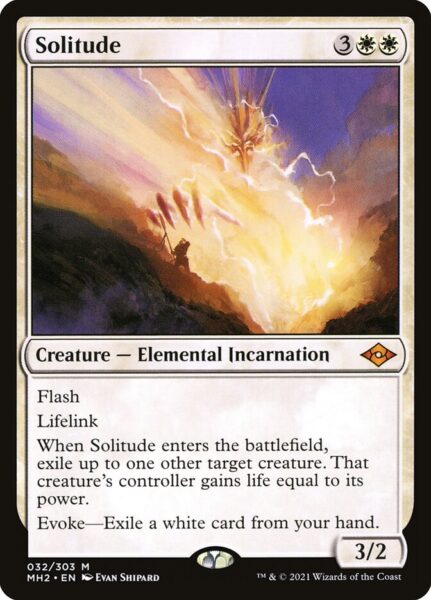
Solitude – the end of Covid lockdown saw the end of my wasting money on foiling out my deck. I’m only missing a few cards at this point. Solitude is one of them. It’s down to about $40 now, which is much better than it used to be. This card is amazing in our deck for reasons I don’t think I need to explain.
ETBs as Card Advantage
Almost as much fun as messing with our opponent’s plan is grinding out value with creatures that net us cards when they enter (just trying it out…). Yeah, that’s going to take some getting used to. We play nine creatures that effectively draw us cards, the best of which tutor up a card of our choice (within reason, that is).
Eternal Witness – sometimes simple is better. For all the flashy new ETB creatures Wizards has printed over the years, this straightforward Human Shaman is arguably our best. Eternal Witness with our commander on the battlefield lets us get back our best card from the graveyard each turn. Want to cast Counterspell every turn? We can do that. Want to fetch a basic land every turn? Done. Want to Ponder and slowly break our opponent’s will by shuffling every turn…I mean, pull ahead on cards? Check. Every Commander deck should have ways to use the graveyard as an extension of the hand. Eternal Witness is one of ours.
Fierce Empath – we have seven targets to fetch with this unassuming Elf, but it really shouldn’t take more than two to close out a game. No one will be surprised to see Craterhoof Behemoth as a finisher in Commander, but it may catch our opponent off guard given how much like a Control deck ours plays in the early game. Our Prison pieces backed up by counter magic, removal, and Planeswalkers will more than likely have opponents thinking we’re really a U/W Control deck splashing Green for our commander and a bit of value. But since much of our interaction comes attached to creatures, Stompy McStomples is a natural inclusion. Fierce Empath lets us go find it.
Spellseeker – another amazing target for our commander’s ability, we have eight cards in our deck to pick from, ranging from spot removal to sweepers to card draw.

Uro, Titan of Nature’s Wrath – it’s not every day Wizards prints a legitimate finisher for only three mana. This Elder Giant dominated Standard and Modern before getting banned and it’s pretty deec in Commander, too. Given our numerous ways of recurring cards from our graveyard, it won’t be too often that we’ll cast Uro for its Escape cost, but, given our numerous ways of recurring cards from our graveyard, we won’t have to. Sun Titan and Uro, Titan of Nature’s Wrath are best friends. Finally, casting Uro on curve is exactly where we want to be with our strategy as it allows us to pull ahead on resources.
Yasharn, Implacable Earth – as a Control-style deck, we never want to miss a land drop. This Elemental Boar all but guarantees we won’t, while also providing us some incidental hate against many Mono Black and Aristocrat strategies.

Greenwarden of Murasa – I love this card. It is likely one of my guilty pleasure cards. That it sees play in only 1% of Commander decks according to edhrec.com confirms this. Every time I want to make cuts for some new hotness, I always look at this card, but never get rid of. It’s tutorable with Fierce Empath and gets us the best card from our graveyard…twice! We have so much early interaction for our opponent to slog through that when we resolve this Elemental and return our best/most annoying piece to our hand, it’s more than card advantage. It’s a blow to our opponent’s will to play Magic.
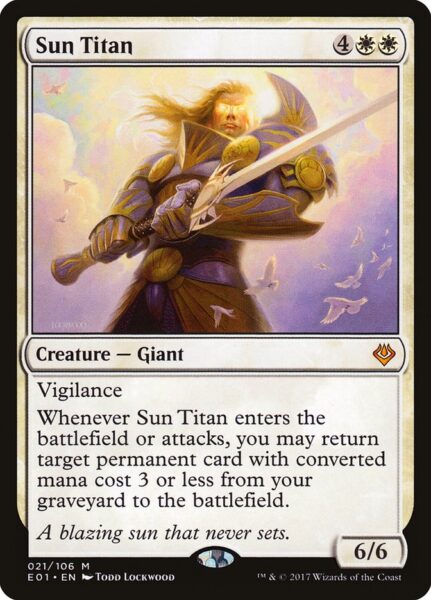
Sun Titan – from the 1% played to the 12% played, this Giant is considered a format staple. From fetch lands to Uro, from Eternal Witness to Spellseeker, Sun Titan can return any of these to the battlefield and grind out games with the best of them. Add Roon of the Hidden Realm into the mix and you get the recipe for a slow, crushing death unseen since Vlad Tepes.
Torrential Gearhulk – another great way we have of recurring cards from our graveyard, this Construct is Snapcaster Mage on steroids. We play 11 instants to target with it, most of which are counters or kills spells. Blinking Torrential Gearhulk each turn is yet another way of crushing our opponent’s will.
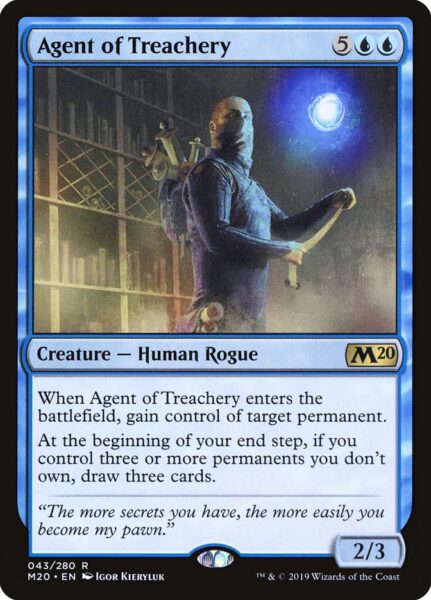
Agent of Treachery – we’ve saved the best for last! What’s more backbreaking than playing against a Counterspell every turn? What’s more salt inducing than seeing a land destroyed at each of your end steps? Having your best permanent stolen repeatedly of course! Besides the dream, though, this 7-drop is one way we have of dealing with a problematic permanent our opponent snuck through our counter magic.

ETBs as Finishers
I’ve already previewed this section in my discussion of Fierce Empath, but I’ll give each card its due.
Craterhoof Behemoth – the best at what it does, this Beast transforms the least-likeliest hodgepodge of creatures into an overwhelming death-dealing force to be reckoned with.
Hornet Queen – another of my most favorite cards, this Insect does more than just bring an army of flying, deathtouch creatures with it to get boosted by Craterhoof Behemoth. She is also great at stabilizing a board we’re behind on or protecting our Planeswalkers.
Moonshaker Cavalry – the new Craterhoof Behemoth, though there really is no replicating the GOAT. Instead of trample, our creatures get flying, which should be enough to win on most boards. The Spirit Knight itself doesn’t get haste, which is unfortunate, but there can be only one Craterhoof!

The Rest
Our remaining creatures support our gameplan or shore up weaknesses in our deck.
Chulane, Teller of Tales – what a fun, powerful card! He’s also an appealing build-around commander. In our deck, though, he functions as a more mana-intensive and slower Roon of the Hidden Realm. Luckily, there’s that big text box in the middle. Drawing cards and getting ahead on mana is exactly where our Creature Control deck wants to be!
Elesh Norn, Mother of Machines – doubles up all of our ETBs while hosing our opponent’s. She’s also one of the cards we really don’t want to see resolved on our opponent’s side of the table.
Roon of the Hidden Realm – what more is there to say about the card the entire deck and article are built on? Well, I just want to point out that we can target our opponent’s creatures, as well. Kaalia of the Vast about to attack and bring a nasty Dragon or Angel with her? Roon can stop that. Opponent about to resolve a Viscera Seer to combo off with Blood Artist? Exile the the portrait-painting Vampire. About to die to some random fatty? You get the picture.
Scavenging Ooze – the odd creature out in this list, the former Modern staple gives us some additional graveyard hate and incidental lifegain. I frequently consider cutting it, but cards like Scavenging Ooze and Endurance are necessary for competitive, grindy decks like this one. Yes, they will frequently not live up to their potential, but when they’re good, there’s nothing else that can do what they do. And, for those new to Commander, graveyard hate is not just for Mono Black Reanimator and the like. If you’ve read all the way to this point in the article, you already know how a card like Scavenging Ooze can nerf some of our cards. Will it shut down our strategy? No. But it can stop us from pulling too far ahead.

Seedborn Muse – I nearly cut this Spirt while making room for an additional land. It definitely feels like a win-more card. However, besides the kind of counter magic we play that can take full advantage of untapping during our opponent’s turn, Seedborn Muse lets us abuse our commander to its full potential. With both cards on the battlefield, we can blink our best hate piece during each of our opponent’s turn, as well. Be aware, though, that creatures blinked with Roon only come back at the end step, so we can’t target our Scheming Fence at the beginning of our opponent’s turn if we want it to take effect that same turn. We can, though, target one of our opponent’s creatures to remove it from the game for their turn.

Synergistic Support Pieces
Much of the rest of our deck is made up of ramp and interaction, whether in the form of instants or Planeswalkers. However, we do have a handful of cards that synergize beautifully with what we’re trying to do, while several more can be used in the right spot to gain us extra value out of our best ETB creature in the moment.
Chulane, Teller of Tales – I’ve already mentioned how this Human Druid functions as a more mana-intensive Roon of the Hidden Realm. There will be games when we have the mana and/or need to get an additional ETB before our end step. Chulane gives us this option where Roon does not.
Elesh Norn, Mother of Machines – doubling up our ETB triggers is as fun as it sounds. MOM is a must-kill threat from our deck.
Jace, the Mind Sculptor – for readers of my article about my Ephara, God of the Polis deck, you’ll be familiar with this fringe use of Jace, as well as our Teferis. Returning a creature like Reflector Mage to our hand will almost always be preferable to returning an opponent’s creature to their hand, assuming we don’t need that mana for a more powerful play. Jace in our deck functions as another copy of Roon, much like Chulane, Teller of Tales. He also does all the other Jace things that make him one of the top 3 Planeswalkers ever printed.
![]()
Panharmonicon – before Elesh Norn, Mother of Machines…before Yarok, the Desecrated…before Roaming Throne…there was Panharmonicon.
Teferi, Hero of Dominaria – it’ll be a rare situation in which we want to tuck our own creature, but I could see using his -3 to protect a creature from our Supreme Verdict if we’re behind on board, for instance.
Teferi, Time Raveler – this -3 returns the creature to our hand and so is a much more reasonable play for us if we’re looking to trigger an ETB again.
Venser, Shaper Savant – while it’s not as much fun returning our own permanent to our hand as it is bouncing an opponent’s land, we can ensure we get a second ETB trigger with this Human Wizard.
Venser, the Sojourner – what a card for our deck! His +2 does exactly what Roon does, while his -1 can win us games out of nowhere. Don’t sleep on this rarely played Planeswalker!
Other Half of Creature Control
When I call this deck a Creature Control strategy, I firstly mean what I’ve detailed above: we use creatures and their ETBs to control the board long enough to turn the corner. However, just because we play Skyclave Apparition and Spell Queller doesn’t mean we can’t or shouldn’t play Swords to Plowshares and Counterspell. As you can read here, I usually don’t include each color’s premier removal spell in all of my Commander decks, as it takes away from the creativity and uniqueness that makes the format so appealing to me.
However, this is my Play Deck. My baby. I’ve done my best to streamline it and make it as powerful as possible to give us game against the super wide field of Commander. I’ve put in my best mana rocks and the free spells that could find a home in any Commander deck, but which I tend to eschew.
Below are the cards that fall under the more traditional Control archetype, divided into card draw, counter magic, and removal. I won’t discuss each one, especially if they appear above, but if you’re new to Control, the TL;DR is that you want cheap ways to answer threats and get ahead on resources. Thus, 1-mana draw spells, 2-mana counter magic, and unconditional sweepers are the bread and butter of any functional Control deck. Planeswalkers are often played in Control strategies because they allow you to pull ahead on resources each turn without further mana investment. I talk more about Control in my article on my Mono-Blue Urza Commander deck.
Card Draw

Cantrips
Brainstorm
Ponder
Preordain
Growth Spiral
Don’t let the longer games and bigger bombs of Commander intoxicate you to the point you neglect the early game and the power of the cantrip. These cheap draw spells are essential to finding answers and making land drops.

Planeswalkers
Jace, Architect of Thought
Jace, the Mind Sculptor
Narset, Parter of Veils – our whiff rate will be higher than most Control decks since we play so many creatures, but shutting down an opponent’s draw spells is reason enough to play this card.
Tamiyo, the Moon Sage – readers of my U/W Flash article will know how much I love this Planeswalker. If I was forced to make this deck as CEDH as possible, I doubt the Moon Sage would find a home here. Thankfully, Commander is as much about playing your favorite cards as playing what’s most powerful or efficient, in my opinion. Tamiyo is largely in this deck for her +1. Tapping down an opponent’s best creature, most busted land, or whatever else may ail us will often buy us enough time to turn the corner.
Teferi, Time Raveler – shutting off our opponent’s instants is a powerful static ability that anyone who’s played Modern in the last 5 years knows all too well. The hate goes deeper than instants, though. Teferi nerfs Cascade, as well.
Teferi, Hero of Dominaria
A note about playing Planeswalkers in this deck. It’s true that with three opponents, it’s hard to keep Planeswalkers alive for long. However, given our main strategy is centered on creatures and their ETBs, unlike most Control decks, we should have creatures in play by the time we cast our Planeswalkers that can protect them. That many of these creatures are also answers to our opponent’s creatures adds to our chances of untapping with our Teferi, Hero of Dominaria and the like.

Enchantments
Sylvan Library – not sure this card needs any explanation, but for those of you who’ve never played it, I’d recommend paying the eight life to draw two extra cards most of the time. The obvious exception is if you are too low on life. The other one is if you really dislike two of the three cards and have a shuffle effect. For example, we can use our fetch lands in conjunction with this enchantment to get rid of the two cards we don’t like much like Legacy players play Brainstorm. I’m not just playing this card because it’s so powerful, though. I also happen to have my copy from High School. It’s a bit beat up, but it’s the Legends version.
The Great Henge – one benefit of playing a Creature Control strategy is that we get to include this legendary artifact that does so much. Ramp, lifegain, creature pumping, and card draw! Yup, it’s from Throne of Eldraine.

Counter Magic
Counterspell
Mana Drain
Fierce Guardianship
Render Silent – another of my favorite cards. Render Silent‘s power level scales up as the game goes long. Nerfing an opponent’s entire turn when they cast a bait spell is why this card makes the 99.
Cryptic Command
Force of Will
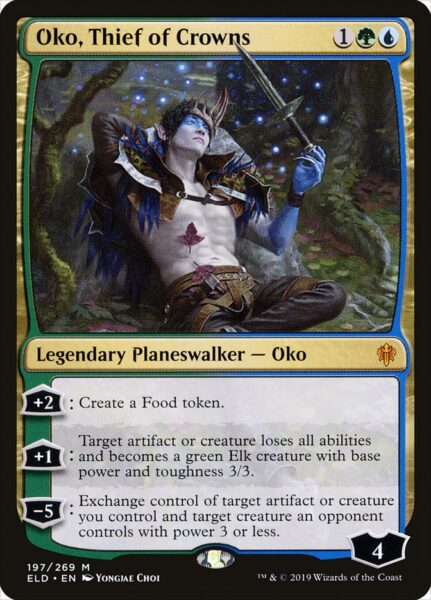
Removal
Swords to Plowshares
Cyclonic Rift
Oko, Thief of Crowns
Elspeth, Sun’s Champion – another of my favorite cards of all time. Her -3 will often be a 1-sided sweeper for us.
Supreme Verdict
Wrath of God
Our removal suite feels a bit on the light side, but when you include all of our creatures and Planeswalkers that can answer problematic permanents and the deck rarely feels like it’s short of answers.
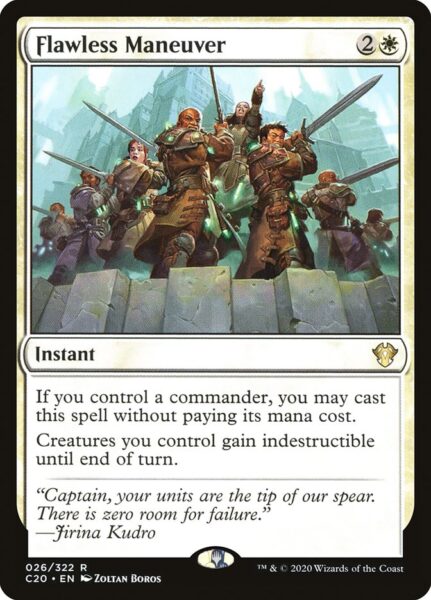
Flex Spots
As usual, one of the best ways to make room for a bunch of cards is to cut a single card from each of the above categories. Going down a single counter spell, kill spell, or ETB creature is unlikely to greatly alter the power of the deck. That being said, if I had to find room for the next most powerful card, I’d consider cutting the following:
Flawless Maneuver – can win us the game in the right spot. It protects our team from sweepers. Cutting this instant won’t hurt the synergies of the deck.
Moonshaker Cavalry – one way decks like ours can stumble is by drawing too many high mana costing spells too early in the game. At 8 mana and triple , we never want to see this card in our first seven draws, much less our opening seven cards. We have Craterhoof Behemoth to close out games quickly, so going down another finisher isn’t going to severely hamstring us. We also have plenty of Planeswalkers we can ultimate, as well as a massive amount of value to gain from blinking our various creatures that we don’t have to rely on a big finisher like Moonshaker Cavalry to win games.
Narset, Parter of Veils – her -2 will often be a liability rather than an advantage.
Magic is full of powerful creatures with amazing ETB effects. If you want to increase the number of creatures to take advantage of this in combination with Roon’s ability, then I could see removing most, if not all, of the Planeswalkers. The mana rock package is on the expensive side money-wise, but I wouldn’t change the number of ramp cards played.

Over the years I’ve made lots of changes to this deck and I haven’t kept track of every creature that has ever made the cut. Suffice it to say there is ample room for customization and/or playing with what’s in your collection. One creature that I only just recently cut, however, is Woodland Bellower. The art is amazing, but the real reason it was in our 99 was that it functioned as a tutor for one of our finishers via Fierce Empath. I highly recommend considering this card for your deck if you’re looking for some powerful, synergistic creatures to fill out the remaining empty slots.
Ideal Hand and Game Play
Since we are essentially a Control deck, our ideal opening seven will have at least three lands, one or two pieces of cheap interaction, and some card draw, ideally a cantrip. Any of our cheap mana rocks will give us our most explosive starts and are at their best when we have a 4- or 5-mana Planeswalker to stick well ahead of curve.
As to game play, we want to make a land drop every turn as we interact with whatever our opponent is up to. Ideally, our early creatures will leave our opponent’s board empty in time for us to resolve a Planeswalker or Roon of the Hidden Realm.
It is perfectly acceptable to use our creatures to interact with our opponent’s plan even with a sweeper in hand. It’s better to hold on to the sweeper for our opponent’s bombs. Most of our early creature spells will deal largely with the first and second wave of our opponent’s strategy. A card like Spell Queller can’t answer the kinds of threats we need Supreme Verdict to address.
Weaknesses
Being a 3-color deck, we are more likely to get colored screwed than some decks. We also have quite a few mana-intensive spells. Drawing the wrong half of our deck (all finishers and Planeswalkers) early will often see us doing a whole lot of nothing until we’re on the brink of death.
Cards like Elesh Norn, Mother of Machines and Doorkeeper Thrull are really good against us. Without ETB triggers, most of our creatures are overcosted, underpowered, and underwhelming. We still have Planeswalkers that can win us some games on the back of their ultimates, but it’s unlikely they’ll live that long if our creatures aren’t doing what they’re supposed to on arrival to the party.
Finally, we are, in essence, a Control deck. The antidote to Control is card draw and recursion so as to run us out of resources. The games I’ve lost the most often are against decks that can keep up with our card advantage one way or another, while putting a great deal of stress on our answers. Zombies can be particularly difficult to beat once they get their graveyard shenanigans online. Against decks like this we need to race them, which means we really want to cast creatures up the curve into our finisher as fast as possible.
Conclusion
This is my Play Deck. It is one of my most favorite decks to play. The cards are so fun and individually powerful that I often forget about my commander entirely. And, in fact, we can win pretty easily without Roon of the Hidden Realm ever seeing action. Our deck is more powerful and effective with him out, but we are far from a commander-centric deck that only functions with our centerpiece card on the battlefield. If you’re looking for a grindy deck that relies on creatures and their ETBs, but also gets to play Planeswalkers and control magic, I’d highly recommend Roon of the Hidden Realm.
Thanks for reading! Do you have a Roon of the Hidden Realm deck? How does it differ from mine? What busted creatures am I forgetting about and should include? Let me know in the comments or email me at johnnycycles16@gmail.com

